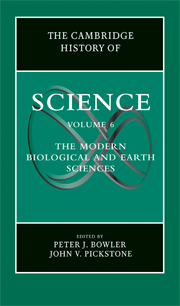Book contents
- Frontmatter
- 1 Introduction
- PART I WORKERS AND PLACES
- PART II ANALYSIS AND EXPERIMENTATION
- 10 Geology
- 11 Paleontology
- 12 Zoology
- 13 Botany
- 14 Evolution
- 15 Anatomy, Histology, and Cytology
- 16 Embryology
- 17 Microbiology
- 18 Physiology
- 19 Pathology
- PART III NEW OBJECTS AND IDEAS
- PART IV SCIENCE AND CULTURE
- Index
- References
17 - Microbiology
from PART II - ANALYSIS AND EXPERIMENTATION
Published online by Cambridge University Press: 28 November 2009
- Frontmatter
- 1 Introduction
- PART I WORKERS AND PLACES
- PART II ANALYSIS AND EXPERIMENTATION
- 10 Geology
- 11 Paleontology
- 12 Zoology
- 13 Botany
- 14 Evolution
- 15 Anatomy, Histology, and Cytology
- 16 Embryology
- 17 Microbiology
- 18 Physiology
- 19 Pathology
- PART III NEW OBJECTS AND IDEAS
- PART IV SCIENCE AND CULTURE
- Index
- References
Summary
The only constant characteristics of a research area that we can, anachronistically, describe as microbiology might be the minute size of the organisms it studies and its reliance on instruments and a set of techniques that allow us to see beyond the range of what is visible to the naked eye. Stability or continuity are difficult to find elsewhere – either in the range and classification of microorganisms, in the types of questions asked about them, in the theoretical or practical goals of research, in the institutions in which investigations were conducted, or in the composition of the group of scientists to whom these microscopic organisms were of interest.
The range of organisms encompassed by these investigations has changed many times during the last two centuries. Relatively undifferentiated infusoria gave place to protists and schizomycetes, and later to protozoa, bacteria, fungi, and algae; the invisible filterable viruses, obligate parasites, and lytic principles appeared only temporarily, to be replaced by rickettsia and viruses. These microorganisms were investigated by a heterogeneous assembly of amateurs, botanists, zoologists, biologists, pathologists, biochemists, geneticists, medical doctors, sanitary engineers, agricultural scientists, veterinarians, public health investigators, biotechnologists, and so on. Specialisms and disciplines devoted to specific groups of microorganisms – bacteriology, virology, protozoology, and mycology – have disparate though often overlapping institutional and intellectual histories, and although the term “microbiology” dates from the last decades of the nineteenth century, it did not come to designate a discipline that could claim its own sphere of concern until after the Second World War.
- Type
- Chapter
- Information
- The Cambridge History of Science , pp. 316 - 341Publisher: Cambridge University PressPrint publication year: 2009
References
- 1
- Cited by



